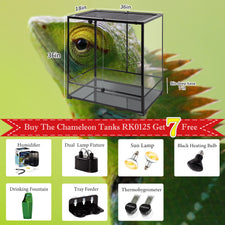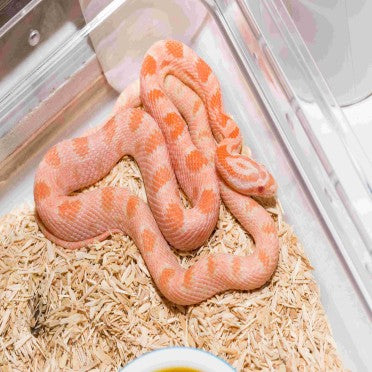Albino corn snakes are among the most sought-after pets among reptile lovers thanks to their easy maintenance and beautiful appearance. These snakes have a very docile nature and are easy to handle, making them an excellent choice for beginners and experienced reptile owners.
However, like all other pets, these amazing reptiles pets need care to keep them healthy and happy. And if you are someone who has recently got an albino corn snake or is thinking of bringing one home, here is all the information you need to get started.
Albino Corn Snakes - A Short Introduction
Albino corn snakes are medium-sized, non-venomous snakes that make great pets for beginner snake owners. Native to the southeastern United States, these snakes get their name due to their widespread presence around corn fields or stores, where they prey on mice and other rodents. However, some people also believe that their name comes from the pattern of the scales on their underbellies, which resemble corn kernels.

As can be expected from their names, these snakes lack pigmentation on their bodies, although that doesn't mean that they are completely white. These reptiles usually have red eyes and pale bodies with distinct red or orange patterns. They are non-venomous and tend to kill their prey by constriction before devouring it. Adult albino corn snakes can grow up to a length of around 5 or 6 feet.
These snakes are quite adaptable and tend to thrive in captivity as long as they are well-cared for. They have simple housing requirements and are well-suited for homes with children due to their non-aggressive behavior. Inquisitive and active, these snakes are fun to watch and are very tolerant of human interaction.
Things To Know Before Getting An Albino Corn Snake
Before you get an albino corn snake as a pet, it's a good idea to be aware of some of the main characteristics of these attractive snakes.
They Come In Different Colors
Albino corn snakes are a variety of corn snakes that lack melanin pigment, resulting in pale bodies. Due to the lack of melanin, you wouldn't find the black marking on their bodies that characterize wild corn snakes.
Instead, their bodies exhibit beautiful patterns in different hues like yellow, orange, white, and red, which gives them a distinct appearance. Their attractive bodies are a major reason for their popularity among reptile owners.
There can be different varieties of albino corn snakes, each differentiated on the basis of the colors and patterns of the markings on their bodies.
They Usually Grow Up To Several Feet In Length
While baby albino corn snakes can be as little as 15 inches in length, adults can be anywhere between 2 to 6 feet in length. Therefore, you will need to get large snake tanks to house them properly. However, these reptiles are quite slender and don't weigh much. In fact, a 4-feet long albino corn snake may weigh just a pound or even less!
These Corn Snakes Have A Long Lifespan In Captivity
While wild corn snakes have a short lifespan of around 6 to 8 years, albino corn snakes usually live longer in captivity. These reptiles can easily live for 15 to 20 years as pets, and it isn't uncommon to find them living for more than 2 decades if well-cared for.
Tail Vibrations Indicate Fear
It's easy to identify whether your pet albino corn snake is feeling frightened or threatened for some reason. These reptiles vibrate their tails when they interpret something as a danger, producing a buzzing sound.
They Are Good Climbers
Albino corn snakes are very good climbers and are great to watch while they are out exploring their snake enclosure. However, this also means that they can easily escape from their housing in case of cracks on the screen cover.
Caring For Your Albino Corn Snake
While albino corn snakes are relatively low maintenance, you must fulfill some basic requirements to ensure their health. Here is everything you need to know about caring for these reptiles.
Snake enclosure Requirements
The size of the enclosure you need to prepare for your albino corn snake depends on how big your new pet is. Albino corn snake hatchlings do not require a lot of space - they can be easily housed in enclosures around the size of a shoe box. However, they will need more space as they grow, so starting with a moderately sized snake tank is a good idea.
In general, a 40-gallon glass snake enclosure is ideal for adult albino corn snakes, although you may need a bigger one depending on how big the reptile is. An easy tip - ensure that the enclosure you buy is at least the same length as your pet’s body. This will ensure they have ample space to move around without feeling too restricted.
Also, remember to add a screen top over the glass enclosure to prevent them from climbing out. You don't want to be searching all over the house for an escaped snake!
It's important to note that albino corn snakes need to be housed individually, except during breeding season. Therefore, if you are thinking of getting more than one snake, you must prepare separate housing for all of them.
Ideal Environment of Albino Corn Snake
Once you have the right enclosure, it's time to start creating the right environment for your reptile buddy. First, fill the enclosure's bottom with a soft, non-abrasive substrate such as aspen shavings or coconut fiber. These snakes love to burrow, so avoiding rough substrate is best.
Next, you need to set up a couple of hides for the snake. You can either get them from a pet store or get creative and make your own. You can also add some fake branches for the snake to climb around.
Coming to temperature, it's best to ensure both a warm and cool side within the enclosure. This will enable the snake to shift to the more comfortable side depending on the time of the day or season. Also, these snakes prefer high humidity, so adding wet tissues or moss might be a good idea.
A water bowl is another necessity. Make sure it's big enough to allow your albino corn snake to wholly submerge its body, and you're good to go! Make sure to replace the water every couple of days or whenever you notice waste or dirt particles.
Cleaning the enclosure is essential for your pet’s health. Make sure to regularly remove any wet substrate to avoid the growth of bacteria. Also, try deep cleaning the enclosure once a month.
Diet
Albino corn snakes usually feed on rodents, so you’ll need to stock up on pre-killed or frozen mice for your pet. Thaw the frozen rodents to room temperature before offering them to the reptile. Feeding live rodents to pet albino corn snakes is not recommended.
The feeding schedule for your snake depends on its life stage. Pinky mice are most suitable for baby albino corn snakes, and they should be fed once every 5 to 7 days. Juveniles and adults can be fed adult mice, not more than once a week. You may need to adjust the feeding schedule depending on your pet's individual requirements.
Snake Health Issues
While albino corn snakes usually live a long and healthy life in captivity, they may face certain health issues depending on their living conditions. Some common illnesses include respiratory illnesses, ticks & mites, dermatitis, stomatitis, etc.
And to ensure your pet’s health, you need to watch for the symptoms of these health issues. Some of the signs to watch out for include the following:
- Refusal to eat
- Shedding issues
- Skin irritation
- Presence of ticks or mites on their bodies or within the enclosure
- Breathing trouble
- Mucus discharge from nostrils or mouth
If your pet exhibits any of the above symptoms or otherwise appears to be in discomfort, it's best to take them to a vet immediately.
Handling Tips
Albino corn snakes respond well to human handling, but that doesn't mean that you should forcefully handle them from day one. Snakes that haven't had much human interaction may find the action threatening and may resort to biting. Although their bite isn't poisonous, it's best to give them time to adjust to your presence before trying to handle them.
It's best to start with small handling sessions of a few minutes and gradually increase the time as your pet grows accustomed to you. You should support the snake’s body without holding them tightly, allowing them to explore the surroundings while being handled. It's recommended to restrict the handling session to once a day or less.
Summing Up
We hope that this albino corn snake care sheet will be useful in helping you prepare yourself for taking care of your new reptile friend. Just give your snake time to adjust to its new home, and you will soon have a calm, lovable, and highly inquisitive pet slithering around.










